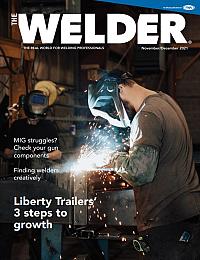Senior Company Trainer
- FMA
- The Fabricator
- FABTECH
- Canadian Metalworking
Categories
- Additive Manufacturing
- Aluminum Welding
- Arc Welding
- Assembly and Joining
- Automation and Robotics
- Bending and Forming
- Consumables
- Cutting and Weld Prep
- Electric Vehicles
- En Español
- Finishing
- Hydroforming
- Laser Cutting
- Laser Welding
- Machining
- Manufacturing Software
- Materials Handling
- Metals/Materials
- Oxyfuel Cutting
- Plasma Cutting
- Power Tools
- Punching and Other Holemaking
- Roll Forming
- Safety
- Sawing
- Shearing
- Shop Management
- Testing and Measuring
- Tube and Pipe Fabrication
- Tube and Pipe Production
- Waterjet Cutting
Industry Directory
Webcasts
Podcasts
FAB 40
Advertise
Subscribe
Account Login
Search
Jim's Cover Pass: Writing out tribal knowledge in a metal fabrication shop
Before experienced welders retire from a shop, it's best to get processes in a system
- By Jim Mosman, AWS, CWI/CWE
- December 5, 2021
- Article
- Shop Management

Tribal knowledge is great in a metal fabrication shop, but what happens when the tribe retires? There are benefits of evaluating manufacturing processes and having written weld procedures to ensure consistent, quality work. Getty Images
Q: Recently I was promoted to shop manager of our small welding fabrication company. This company has always trained the employees for specific jobs by having them work with the senior welders to gain tribal knowledge. I would like to create some work instructions and use welding procedures, but I just don’t know where to begin.
A: While many companies have survived for years by passing on information this way, it is always good to have written procedures to maintain integrity.
First—and this will take the most time and effort—you will need to begin documenting current procedures. Be certain that all of your welding power sources are calibrated for amperage and voltage. For every project or product that is manufactured, request that the welder document the process, electrodes, gases, amperage, voltage, wire feed speed, heat treatment, and any other critical data. You will also need to document the material type, size, cut length, and order of operation. This may also include any required preparation such as sawing, shearing, bending, and machining before and after each part or project is complete. You might also want to document the reasonable amount of time required to produce the product.
Next, as you review all of the data collected and begin to create the work instruction sheet, it would be beneficial to include the senior welders in the discussion. Match this information with a technical drawing or print of each part. Decide the appropriate range of parameters that are acceptable. The completed work instruction and technical print need to be written in a way that even a novice employee can follow. Determine if your products should be following any of the welding codes by AWS, ASME, API, or any other regulatory organization. If so, then the appropriate codes will need to be acquired and followed.
Finally, use the collected data to create the welding procedure specification (WPS), and test the procedure to create the procedure qualification record (PQR). Each welder will be required to test and qualify for every welding procedure involved with the manufacture of a stated product. You may find that some of the employees are better-suited to various procedures and processes.
This type of undertaking usually takes a fair amount of time and persistence. It also requires the buy-in of both administration and employees. Documentation also involves periodic review and changes when required. By using proper work instructions, quality technical prints, and documented procedures, you can help your company develop a strategic approach to effective, efficient, and economically productive manufacturing.
About the Author

Jim Mosman, AWS, CWI/CWE
Lincoln Electric Education Division
About the Publication
Related Companies
subscribe now

The Welder, formerly known as Practical Welding Today, is a showcase of the real people who make the products we use and work with every day. This magazine has served the welding community in North America well for more than 20 years.
start your free subscription- Stay connected from anywhere

Easily access valuable industry resources now with full access to the digital edition of The Fabricator.

Easily access valuable industry resources now with full access to the digital edition of The Welder.

Easily access valuable industry resources now with full access to the digital edition of The Tube and Pipe Journal.
- Podcasting
- Podcast:
- The Fabricator Podcast
- Published:
- 04/16/2024
- Running Time:
- 63:29
In this episode of The Fabricator Podcast, Caleb Chamberlain, co-founder and CEO of OSH Cut, discusses his company’s...
- Trending Articles
Sheffield Forgemasters makes global leap in welding technology

Welding student from Utah to represent the U.S. at WorldSkills 2024

Lincoln Electric announces executive appointments

Lincoln Electric acquires RedViking

Engine-driven welding machines include integrated air compressors

- Industry Events
16th Annual Safety Conference
- April 30 - May 1, 2024
- Elgin,
Pipe and Tube Conference
- May 21 - 22, 2024
- Omaha, NE
World-Class Roll Forming Workshop
- June 5 - 6, 2024
- Louisville, KY
Advanced Laser Application Workshop
- June 25 - 27, 2024
- Novi, MI



























